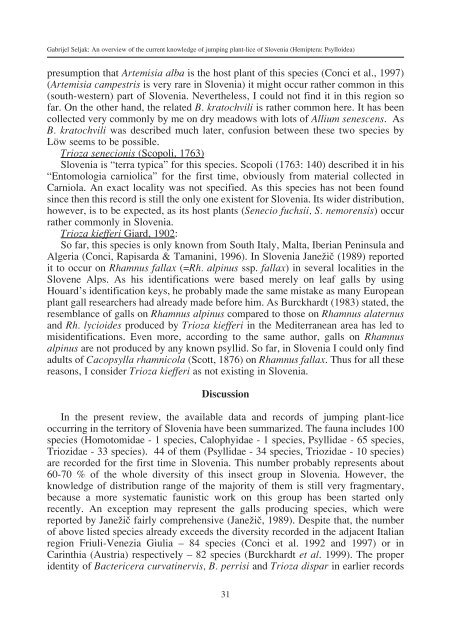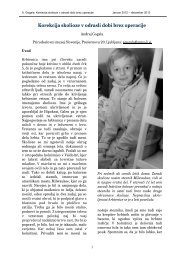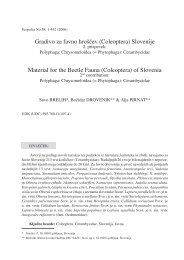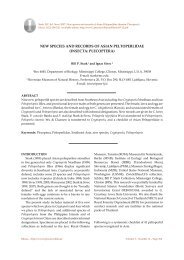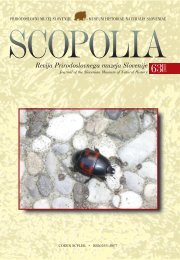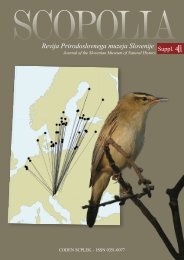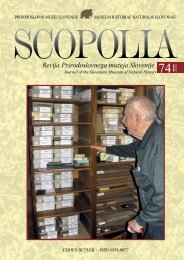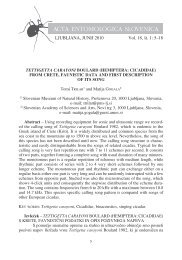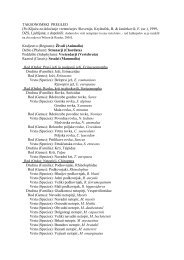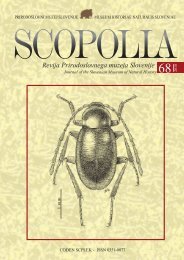Acta entomologica slovenica, 14 (1), 2006around Lesce and Bled (Lees-Valdes at that time) (Löw, 1881). Now this regionbelongs to Slovenia. Conci & Tamanini (1990), however, placed this type locality inAustria and Carinthia (Kärnten), what is wrong. Namely, even at that time this regionbelonged to the district Krain, which is now a part of the present Slovenia and not toCarinthia. Such misinterpretations are not rare for all of the species described at thattime in the territory of the Austrian-Hungarian monarchy, which is not surprising dueto the immense geopolitical changes, which followed afterwards.Acizzia jamatonica (Kuwayama, 1908):This eastern Palaearctic species has spread from Italy to Slovenia only veryrecently (Seljak, 2003; Seljak et al., 2004). In Europe it was recorded in North Italyfor the first time (Alma et al., 2002). As early as in 2002 large populations werefound on its host plant Albizia julbrissin in parks in Nova Gorica and soon elsewherealong the Slovene-Italian border as well. In 2003, it was found to be spread all overthe south-western submediterranean part of Slovenia, and actually everywhere whereits host plant is found planted (parks, parking places, gardens). Also in 2002, it wasspreading also towards south in Istria (Umag, Poreœ, Rovinj - Croatia). According toØimala et al. (2006) it is continuing to spread along the coastal area in Dalmatia. Theinsect spreads mainly by being carried by traffic along the road network sand, partlyalso by active flying in searching for still unoccupied Albizia trees. Now it isconsidered as a very serious pest of Albizia julbrissin, threatening its ornamentalvalue and functionality. Due to the weak lignification of shoots, heavy affected treesmay often get frozen during the following winter.Phylloplecta trisignata (Löw, 1886):This species is widely distributed throughout the whole Mediterranean (FaunaEuropaea, 2004). Its occurrence in Istria (Voloøœa, Croatia) was already recorded byGräffe (1911). A specimen captured on a yellow sticky trap in the Slovene coastalarea (Parecag) in 2004 confirms its existence in this part of Europe.Diaphorina chobauti Puton, 1898It is a very rare species in Europe. According to Burckhardt (1984) and Conci etal. (1993) it has only been known from Liguria in North-Italy so far. Otherwise, it iswidely distributed throughout the Near East, in North Africa and in the central Asia(Burckhardt, 1984, Gegechkori & Loginova, 1990, Conci et al., 1993). In Slovenia,there are only three localities known in the southwestern submediterranean part ofthe country. Another locality has been discovered near the village Doberdob on theItalian side. However, all these localities are quite close together and belong to thesame geographical region (fig. 5). Specimens were always swept from Convolvuluscanthabrica L. plants, mostly at the end of May and in the early June. One specimenhowever was found the 01.10.2005. As Conci et al. (1993) in Italy give similarcollecting periods, it is suggested that the species develops two generations per year.Bactericera perrisi Puton, 1876There are some uncertainties about the occurrence of this species in Slovenia.Löw (1888) recorded it from Gorica (Görz) and Trnovski gozd (Tarnovaner Wald),which were also the only known localities in the territory of Monarchy at that time.Later Graeffe (1911) recorded it to occur also near Triest (Proseco). Under the30
Gabrijel Seljak: An overview of the current knowledge of jumping plant-lice of Slovenia (Hemiptera: Psylloidea)presumption that Artemisia alba is the host plant of this species (Conci et al., 1997)(Artemisia campestris is very rare in Slovenia) it might occur rather common in this(south-western) part of Slovenia. Nevertheless, I could not find it in this region sofar. On the other hand, the related B. kratochvili is rather common here. It has beencollected very commonly by me on dry meadows with lots of Allium senescens. AsB. kratochvili was described much later, confusion between these two species byLöw seems to be possible.Trioza senecionis (Scopoli, 1763)Slovenia is “terra typica” for this species. Scopoli (1763: 140) described it in his“Entomologia carniolica” for the first time, obviously from material collected inCarniola. An exact locality was not specified. As this species has not been foundsince then this record is still the only one existent for Slovenia. Its wider distribution,however, is to be expected, as its host plants (Senecio fuchsii, S. nemorensis) occurrather commonly in Slovenia.Trioza kiefferi Giard, 1902:So far, this species is only known from South Italy, Malta, Iberian Peninsula andAlgeria (Conci, Rapisarda & Tamanini, 1996). In Slovenia Janeæiœ (1989) reportedit to occur on Rhamnus fallax (=Rh. alpinus ssp. fallax) in several localities in theSlovene Alps. As his identifications were based merely on leaf galls by usingHouard’s identification keys, he probably made the same mistake as many Europeanplant gall researchers had already made before him. As Burckhardt (1983) stated, theresemblance of galls on Rhamnus alpinus compared to those on Rhamnus alaternusand Rh. lycioides produced by Trioza kiefferi in the Mediterranean area has led tomisidentifications. Even more, according to the same author, galls on Rhamnusalpinus are not produced by any known psyllid. So far, in Slovenia I could only findadults of Cacopsylla rhamnicola (Scott, 1876) on Rhamnus fallax. Thus for all thesereasons, I consider Trioza kiefferi as not existing in Slovenia.DiscussionIn the present review, the available data and records of jumping plant-liceoccurring in the territory of Slovenia have been summarized. The fauna includes 100species (Homotomidae - 1 species, Calophyidae - 1 species, Psyllidae - 65 species,Triozidae - 33 species). 44 of them (Psyllidae - 34 species, Triozidae - 10 species)are recorded for the first time in Slovenia. This number probably represents about60-70 % of the whole diversity of this insect group in Slovenia. However, theknowledge of distribution range of the majority of them is still very fragmentary,because a more systematic faunistic work on this group has been started onlyrecently. An exception may represent the galls producing species, which werereported by Janeæiœ fairly comprehensive (Janeæiœ, 1989). Despite that, the numberof above listed species already exceeds the diversity recorded in the adjacent Italianregion Friuli-Venezia Giulia – 84 species (Conci et al. 1992 and 1997) or inCarinthia (Austria) respectively – 82 species (Burckhardt et al. 1999). The properidentity of Bactericera curvatinervis, B. perrisi and Trioza dispar in earlier records31
- Page 1: Vsebina / ContentsL. SENŒIŒ: Inte
- Page 4: ISSN 1318-1998CODEN: AESLFMUDC (UDK
- Page 7 and 8: ACTA ENTOMOLOGICA SLOVENICALJUBLJAN
- Page 9 and 10: Leon Senœiœ: Intensity of wing pi
- Page 11 and 12: Leon Senœiœ: Intensity of wing pi
- Page 13 and 14: ACTA ENTOMOLOGICA SLOVENICALJUBLJAN
- Page 17 and 18: Gabrijel Seljak: An overview of the
- Page 19 and 20: Gabrijel Seljak: An overview of the
- Page 21 and 22: Gabrijel Seljak: An overview of the
- Page 23 and 24: Gabrijel Seljak: An overview of the
- Page 25 and 26: Gabrijel Seljak: An overview of the
- Page 27 and 28: Gabrijel Seljak: An overview of the
- Page 29 and 30: Gabrijel Seljak: An overview of the
- Page 31: Gabrijel Seljak: An overview of the
- Page 35 and 36: Gabrijel Seljak: An overview of the
- Page 37 and 38: ACTA ENTOMOLOGICA SLOVENICALJUBLJAN
- Page 39 and 40: Bojan Kofler: Anophthalmus miroslav
- Page 41 and 42: Bojan Kofler: Anophthalmus miroslav
- Page 43 and 44: Bojan Kofler: Anophthalmus miroslav
- Page 45 and 46: ACTA ENTOMOLOGICA SLOVENICALJUBLJAN
- Page 47 and 48: Tone Lesar, Matjaæ Jeæ: Prispevek
- Page 49 and 50: Tone Lesar, Matjaæ Jeæ: Prispevek
- Page 51 and 52: Tone Lesar, Matjaæ Jeæ: Prispevek
- Page 53 and 54: Tone Lesar, Matjaæ Jeæ: Prispevek
- Page 55 and 56: Tone Lesar, Matjaæ Jeæ: Prispevek
- Page 57 and 58: ACTA ENTOMOLOGICA SLOVENICALJUBLJAN
- Page 59 and 60: Ivana Æiviå, Zoran Markoviå, Mil
- Page 61 and 62: Ivana Æiviå, Zoran Markoviå, Mil
- Page 63 and 64: Ivana Æiviå, Zoran Markoviå, Mil
- Page 65 and 66: Ivana Æiviå, Zoran Markoviå, Mil
- Page 67 and 68: Ivana Æiviå, Zoran Markoviå, Mil
- Page 69 and 70: Ivana Æiviå, Zoran Markoviå, Mil
- Page 71 and 72: ACTA ENTOMOLOGICA SLOVENICALJUBLJAN
- Page 73 and 74: Ljiljana Protiå: Nabidae (Heteropt
- Page 75 and 76: Ljiljana Protiå: Nabidae (Heteropt
- Page 77 and 78: Ljiljana Protiå: Nabidae (Heteropt
- Page 79 and 80: Ljiljana Protiå: Nabidae (Heteropt
- Page 81 and 82: Ljiljana Protiå: Nabidae (Heteropt
- Page 83 and 84:
ACTA ENTOMOLOGICA SLOVENICALJUBLJAN
- Page 85 and 86:
M Aydogdu, A. Beyarslan: First reco
- Page 87 and 88:
M Aydogdu, A. Beyarslan: First reco
- Page 89 and 90:
M Aydogdu, A. Beyarslan: First reco
- Page 91 and 92:
ACTA ENTOMOLOGICA SLOVENICALJUBLJAN
- Page 93 and 94:
Emine Demir: Preliminary report on
- Page 95 and 96:
Emine Demir: Preliminary report on
- Page 97 and 98:
Emine Demir: Preliminary report on
- Page 99 and 100:
Emine Demir: Preliminary report on
- Page 101 and 102:
Emine Demir: Preliminary report on
- Page 103 and 104:
Emine Demir: Preliminary report on
- Page 105 and 106:
Favnistiœni zapiski / Faunistical
- Page 107 and 108:
Abdullah Hasbenli, Fatma Bayrakdar,
- Page 109 and 110:
Vabilo na Prvi slovenski entomoloø


